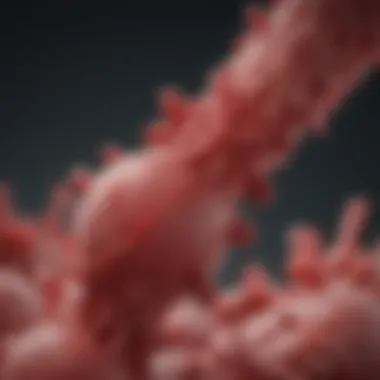Understanding Factor Seven Deficiency: Clinical Insights


Intro
Factor VII deficiency, while often overshadowed by other bleeding disorders such as hemophilia, deserves a closer examination. This rare condition hinges on the inadequate production of coagulation factor VII, which plays a crucial role in the blood clotting cascade. Without sufficient levels of this protein, even minor injuries can lead to excessive bleeding, raising insight into the fragility of human physiology in the face of genetic complexities.
Understanding this disorder is vital not only for those affected but also for medical professionals involved in hematology and genetics. This article will guide you through the intricate web of Factor VII deficiency, exploring its clinical implications, genetic underpinnings, diagnostic methods, and treatment avenues. Therefore, let us embark on this journey to unravel the multifaceted nature of this disorder.
Understanding Factor Seven and Its Role in Hemostasis
Factor VII plays a critical role in hemostasis, the process that prevents and stops bleeding. Understanding how this factor functions is pivotal, especially when grappling with disorders like Factor Seven deficiency. Hemostasis is a complex series of events involving blood vessel constriction, platelet aggregation, and coagulation. Each element in this cascade has a specific function, and any disruption can lead to significant clinical implications.
The Coagulation Cascade
The coagulation cascade is often described as a detailed orchestration involving numerous proteins that work together to form a clot. Factor VII, which is produced in the liver, is one of the initial catalysts in this intricate process. When activated, Factor VII interacts with tissue factor (TF) exposed during vascular injury. This interaction is the spark that ignites the cascade, prompting a series of reactions that ultimately lead to fibrin clot formation.
The cascade can be divided into two main pathways: the intrinsic and the extrinsic pathways. Factor VII predominantly operates within the extrinsic pathway. When tissue factor binds to activated Factor VII, it becomes Factor VIIa, which then activates Factors IX and X. This activity highlights the importance of Factor VII, not only as participant but also as a critical regulator of clot formation.
"The coagulation cascade is an elegant dance of proteins, with Factor VII leading the charge when injury occurs."
The precision required in this cascade means that any deficiencies can result in serious issues. In individuals with Factor Seven deficiency, the deficiency manifests as a failure in the activation of this cascade, leading to inadequate clot formation during injuries or surgeries, heightening the risk of excessive bleeding.
Importance of Factor
Factor VII is like the linchpin of the coagulation process. Its significance cannot be overstated when one considers its role as an initiator of coagulation responses. Patients with Factor Seven deficiency often face bleeding challenges that can drastically affect their quality of life!
From minor cuts that take longer to heal to major surgeries where clot formation is expected, the presence of adequate Factor VII is crucial. Clinically, it translates to frequent medical evaluations, potential blood transfusions, and sometimes, an increased need for supportive treatments. The emphasis on understanding Factor VII is not just about knowing the science; it's about appreciating the human stories of those affected by the disorder. Living with Factor Seven deficiency requires ongoing awareness and management strategies tailored to each individual’s needs.
As we dive deeper into the pathology of Factor Seven deficiency in later sections, we will reflect on how the role of Factor VII in hemostasis is intricately connected to the clinical experiences of those individuals affected. Truly, Factor VII is not just a coagulation factor; it's a key player in the broader narrative of patient care.
Defining Factor Seven Deficiency
Factor Seven deficiency represents more than just a clinical phenomenon; it serves as a crucial part of understanding hemophilia and related bleeding disorders. This section seeks to demystify the nuances of this bleeding disorder by outlining its pathophysiology and variations in severity. Grasping these components is vital, as it facilitates better patient management and paves the way for future therapeutic advancements.
Pathophysiology of the Disorder
To comprehend Factor Seven deficiency, one must first delve into its underlying pathophysiology. The disorder stems from an inadequate volume of Factor VII, a glycoprotein that plays a pivotal role in the coagulation cascade. When the clotting mechanism is triggered, Factor VII converts to its active form, Factor VIIa, which interacts with tissue factor. This engagement is crucial for the activation of other factors, ultimately leading to a stable blood clot. Without sufficient Factor VII, patients experience impaired hemostasis, making them prone to abnormal bleeding.
In terms of genetics, the disorder is typically hereditary, often passed down as an autosomal recessive trait. Mutations in the F7 gene interfere with the normal production or function of Factor VII. These mutations can vary significantly; some may lead to slight reductions in protein levels, while others result in a total absence. A deeper understanding of these genetic factors can inform approaches to diagnosis and treatment.
"Understanding the mechanisms behind Factor Seven deficiency allows for instilling hope in those afflicted, as advancements in personalized treatment continue to emerge."
Severity Variations in Factor Seven Deficiency


The severity of Factor Seven deficiency isn’t a uniform experience; it can range from mild to severe. This variation largely depends on the degree of Factor VII deficiency, which in turn influences the clinical manifestations observed in patients.
- Mild Deficiency: Patients with mild Factor Seven deficiency might lead normal lives with a minimal risk of bleeding. For these individuals, spontaneous bleeds are infrequent, and any bleeding episodes are typically minor and can often be managed without specific treatment.
- Moderate to Severe Deficiency: On the other hand, individuals with moderate to severe deficiencies may experience serious bleeding episodes, even after minor injuries. This heightened risk can lead to complications such as hemarthrosis, a condition that involves bleeding into joints, causing pain and potential long-term damage.
Understanding these variations in severity is paramount for clinicians, as it aids in tailoring patient-specific management strategies. Knowing who is at more significant risk allows healthcare professionals to preemptively address complications and provide necessary interventions.
Genetics Behind Factor Seven Deficiency
Understanding the genetic factors that underpin Factor Seven deficiency is essential in shedding light on how this disorder manifests and is inherited. This section delves into the inheritance patterns associated with the condition as well as the specific genetic mutations linked to it. Knowing these aspects not only helps in diagnosing and managing the disorder but also opens doors for potential therapies tailored to individual patients.
Inheritance Patterns
Factor Seven deficiency is primarily inherited in an autosomal recessive manner. This means that a person must inherit two copies of the mutated gene—one from each parent—to develop the condition. Here are important points to consider when discussing inheritance patterns:
- Carrier Parents: Parents who carry one copy of the mutated gene typically do not show symptoms but have a 25% chance of having an affected child with each pregnancy.
- Variable Expression: Even among siblings, the expression of the disorder can differ, leading to varying degrees of symptoms and bleeding risk.
- Geographic Variability: Certain populations may show higher incidences of carrier status due to historical factors such as a limited gene pool or environmental influences.
A thorough family history can assist in identifying carrier status and risk factors, making it crucial for families affected by the disorder.
Genetic Mutations Associated with the Disorder
The most common genetic mutations linked to Factor Seven deficiency occur in the F7 gene, located on chromosome 13. These mutations can lead to either a complete lack of Factor VII protein or the production of a non-functional protein. Some critical aspects include:
- Types of Mutations: Point mutations, small deletions, and insertions can all contribute to impaired production of factor VII. These mutations may disrupt the coding sequence of the gene or affect its regulatory elements.
- Functional Effects: Mutations in the F7 gene often result in lower levels of circulating Factor VII, which is crucial for the coagulation cascade. The severity of bleeding episodes can often correlate with the residual levels of Factor VII.
- New Discoveries: Advances in genomic technologies have allowed for a better understanding of the variations, and ongoing research aims to characterize these mutations further. Identifying specific mutations could lead to insights into the variability of clinical presentations among affected individuals.
"Genetic testing has not only aided in diagnosis but also in the family's ability to make informed reproductive choices."
Clinical Manifestations and Symptoms
Understanding the clinical manifestations and symptoms of Factor Seven deficiency is crucial for both medical professionals and patients. Recognizing these signs can lead to earlier diagnosis and appropriate management, which is pivotal in minimizing health complications. The visibility of symptoms can vary significantly between individuals, making awareness essential. This section delves into the typical bleeding episodes that individuals may encounter and underlines the potential consequences when such symptoms go unchecked.
Bleeding Episodes: Types and Triggers
Factor Seven deficiency often presents itself through various bleeding episodes. These episodes can manifest differently depending on several factors. Here are some common types:
- Mucosal Bleeding: This type typically occurs in areas like the gums or nose. Individuals might notice unexpected bleeding when brushing teeth or a prolonged nosebleed that refuses to stop.
- Cutaneous Hemorrhages: These are often petechiae or purpura, small red or purple spots on the skin. They are a telltale sign that something is amiss with clotting.
- Joint Bleeding: Known as hemarthrosis, this can lead to swollen and painful joints. Such bleeding episodes can affect mobility and are particularly common in more severe cases.
Triggers for these bleeding episodes vary widely. Common factors include:
- Physical Trauma: Even minor injuries can lead to significant bleeding. For many, simple activities like playing sports can become sources of anxiety.
- Surgical Procedures: Any surgery can amplify the risk of bleeding. Hence, preoperative assessment is critical for these patients.
- Medications: Certain drugs, especially anticoagulants, can exacerbate bleeding tendencies. Awareness about medication interactions is important to prevent serious complications.
"Recognizing the types and triggers of bleeding episodes can significantly improve the quality of life for those with Factor Seven deficiency."
Consequences of Untreated Deficiency


The aftermath of ignoring Factor Seven deficiency can be severe. Without timely diagnosis and treatment, patients may face a host of complications that affect their overall health. Some notable consequences include:
- Chronic Joint Issues: Recurrent bleeding into the joints can lead to chronic pain and arthritis, greatly diminishing physical activity.
- Life-Threatening Bleeding: Severe cases may result in hemorrhagic events that can be fatal. This is particularly relevant during surgeries or dental procedures, where the risk is heightened.
- Psychosocial Impacts: The constant threat of bleeding episodes can lead to anxiety and depression. Everyday activities may become daunting, affecting social interactions and quality of life.
- Cumulative Health Risks: Over time, untreated or mismanaged symptoms can lead to additional health problems, complicating the clinical picture.
In summary, understanding the clinical manifestations and symptoms of Factor Seven deficiency is not merely an academic exercise but a fundamental aspect of effective patient care. By recognizing signs early, healthcare providers can initiate appropriate interventions to improve outcomes for those affected.
Diagnosis of Factor Seven Deficiency
Diagnosing factor seven deficiency is crucial not only for the management of the condition but also for guiding appropriate treatment strategies. Early detection can significantly alter the patient’s journey, allowing healthcare professionals to provide timely interventions. Without diagnosis, individuals may face prolonged periods of unexplained bleeding, leading to complications that could’ve been forestalled.
Laboratory Tests and Procedures
Laboratory tests play a central role in diagnosing factor seven deficiency. The primary test employed is the prothrombin time (PT), which assesses the time it takes for blood to clot. Elevated PT levels may indicate a deficiency in one or more of the factors, including factor VII. However, confirmation of factor seven deficiency typically requires further specific testing. Here are some key components of the diagnostic process:
- Coagulation Factor Assays: This measures the activity levels of coagulation factors in the blood. Assessing factor VII activity is essential and often involves functional assays rather than just antigen levels, as the latter may not reflect the bleeding risk accurately.
- Genetic Testing: After the clinical diagnosis, genetic testing can identify any underlying mutations in the F7 gene responsible for the deficiency. This not only aids in confirming the diagnosis but can also have implications for family members.
- Complete Blood Count (CBC): Performing a CBC helps rule out other conditions that might contribute to bleeding symptoms. While CBC won’t diagnose factor seven deficiency directly, it provides useful context in evaluating a patient’s overall blood health.
These tests must be interpreted by experienced professionals to distinguish between different bleeding disorders that exhibit similar symptoms. Misdiagnosis can lead to inappropriate treatment plans and worsening of the patient’s condition.
Differential Diagnosis Considerations
When evaluating for factor seven deficiency, it’s essential to consider other potential causes of bleeding. Here are some disorders that might appear similar:
- Hemophilia A and B: Caused by deficiencies in factor VIII or factor IX, these hemophilias share symptoms with factor seven deficiency but require different management approaches.
- Vitamin K Deficiency: This can lead to a generalized coagulopathy, affecting several coagulation factors, including factor VII.
- Liver Disease: Chronic liver conditions often interfere with the synthesis of clotting factors, presenting a complex clinical picture.
- Disseminated Intravascular Coagulation (DIC): This serious condition causes systemic activation of coagulation leading to significant bleeding. It’s crucial to distinguish it from isolated factor seven deficiency.
The importance of differential diagnosis cannot be overstated. An accurate diagnosis requires a thorough review of the patient's history, clinical symptoms, and appropriate laboratory testing.
Treatment Approaches for Factor Seven Deficiency
Understanding treatment options for factor seven deficiency holds great significance for individuals affected by this condition. The rarity of the disorder often results in a lack of awareness among healthcare practitioners and the general public, making effective management critical. Finding appropriate treatment pathways can significantly improve the quality of life for patients.
Current Therapeutic Options
At the moment, managing factor seven deficiency leans heavily on the use of recombinant factor VIIa. This synthetic version of the naturally occurring factor VII plays a pivotal role in promoting hemostasis. Patients typically receive administration through intravenous infusions. Given its potency, this treatment needs to be tailored to individual circumstances.
Some relevant therapeutic options include:
- Recombinant Factor VIIa: This is a widely used treatment. It not only helps in managing bleeds but also assists during surgical procedures in individuals with severe deficiency.
- Desmopressin (DDAVP): While more commonly associated with von Willebrand disease, some cases of mild and moderate factor seven deficiency may benefit from this drug due to its ability to stimulate the release of von Willebrand factor and factor VIII.
- Prothrombin Complex Concentrates (PCCs): This can also be utilized, although it is less common and not as well-studied for factor seven deficiency specifically compared to factor VIIa.
Beyond these options, supportive care remains an essential part of managing the condition. Patients are often encouraged to engage in preventive measures and to be vigilant about monitoring for signs of bleeding, especially during high-risk situations such as surgery or trauma.
Emerging Treatments and Research
The landscape of factor seven deficiency treatment is continuously evolving. Recent advancements in research are leaning toward novel gene therapy approaches as potential future treatments. Researchers hypothesize that by introducing a functional copy of the factor VII gene into the patient's cells, the body could produce sufficient amounts of the protein, potentially alleviating the dependency on factor VIIa infusions.


Other areas of research include:
- Antibody therapies: These aim to neutralize inhibitors that might develop against factor VII, helping in managing patients who become resistant to standard therapies.
- Long-acting factor replacement products: Such innovations aim to reduce the frequency of infusions, making life considerably easier for patients who depend on regular treatment.
"The future of factor seven deficiency treatment lies not just in managing symptoms but rather in addressing the root causes of the disorder through advanced therapies."
As these treatments journey through the stages of clinical trials, the efficacy and safety profiles will gradually become clear. Continuous investment in research is vital, as it may significantly alter the daily lives of those living with factor seven deficiency, creating hope for a more manageable future.
Living with Factor Seven Deficiency
Living with Factor Seven deficiency presents unique challenges that can affect every aspect of daily life. Understanding the nuances and implications of this condition is essential for patients and their families, as it leads to more effective management and better outcomes. The central theme in navigating life with this disorder focuses on maintaining awareness, fostering education, and building a robust support network.
Patient Education and Support
Effective patient education is indispensable for those living with Factor Seven deficiency. When individuals are well-informed, they are empowered to take proactive steps in managing their health. This knowledge begins with understanding the nature of the disorder, which can greatly reduce anxiety and uncertainty.
Informational resources, like medical blogs or support groups, help demystify the disorder and provide essential guidance. Patients can learn about the signs of bleeding, the importance of early intervention, and what to do in case of emergencies. They should be aware of:
- Signs of Bleeding: Recognizing when bleeding is abnormal and how to respond.
- Emergency Protocols: Understanding the steps to take when a bleeding episode occurs, including when to seek urgent care.
- Regular Follow-Up: Keeping up with medical appointments to monitor their condition effectively.
Support groups, either in person or virtual forums, act as pillars of strength. Engaging with others who face similar challenges offers emotional comfort and practical advice. Discussions can range from coping strategies to sharing personal experiences, all of which contribute to a more enriched understanding of the condition and the community.
"Education is the most powerful weapon which you can use to change the world." – Nelson Mandela. This rings particularly true in managing health conditions like Factor Seven deficiency, where understanding can lead to resilience.
Lifestyle Considerations and Management Strategies
For individuals living with Factor Seven deficiency, lifestyle adjustments play a crucial role in managing the condition. Practical strategies can enhance quality of life and minimize the risks tied to bleeding events. Here are several considerations worth noting:
- Dietary Choices: Some researches suggest that foods rich in vitamin K may positively influence clotting factors. Patients should consult with healthcare providers to tailor a diet that supports their unique needs.
- Physical Activity: Regular but low-impact exercises, such as walking or swimming, can keep the body fit without risking injury. Patients should engage in safe activities that promote physical health while avoiding high-contact sports or risky maneuvers that may lead to trauma.
- Medication Management: Any treatment plan must include careful medication usage. Certain medications can adversely affect clotting, so it is vital for patients to coordinate with healthcare providers about all prescriptions and over-the-counter drugs.
- Stress Management: Chronic stress can exacerbate health conditions, including bleeding disorders. Practices such as meditation, yoga, or simply spending time in nature can help decrease stress levels.
Finale and Future Directions
In wrapping up the discussion on factor seven deficiency, it's vital to underscore the implications of not just what we've seen thus far, but what lies ahead for individuals impacted by this condition. The complexities surrounding factor VII deficiency invite a deeper contemplation of both immediate and long-term strategies for management, treatment, and research. As highlighted throughout this article, living with such a rare bleeding disorder is fraught with uncertainties and challenges. However, advancing our understanding is a powerful tool in shaping future care.
Summary of Key Findings
This article has illuminated a number of pivotal aspects of factor seven deficiency, weaving together its medical, genetic, and clinical ramifications. Key findings include:
- Foundation of the Disorder: Factor VII plays an essential role in blood coagulation, and its deficiency can lead to severe bleeding episodes. The rarity of this disorder means that awareness and education are crucial to manage it effectively.
- Genetic Underpinnings: Genetic mutations contribute significantly to the disorder. These mutations can show varied inheritance patterns that inform us not only about the condition itself, but also its potential onset in familial contexts.
- Diagnosis and Treatment: Accurate diagnosis through proper laboratory tests is paramount, as is access to timely treatment. Current therapies can manage bleeding episodes, yet emerging treatments hold promise for better outcomes.
- Patient Management: Life with factor seven deficiency requires tailored patient education and management strategies. Understanding the triggers for bleeding episodes and having strategies in place can improve quality of life.
These nuggets of wisdom serve as a cornerstone for ongoing dialogues regarding factor seven deficiency.
Importance of Continued Research
Ongoing research into factor seven deficiency is not just beneficial; it is essential. Considerations surrounding this area extend well beyond the research lab. Continuous studies offer multiple facets to explore:
- Developing Innovative Treatments: There is potential for new therapies that may significantly reduce the risk of bleeding. Innovations in biotechnology and pharmacology can help provide much-needed breakthroughs for patients.
- Enhanced Understanding of Genetics: With genomic sequencing becoming more accessible, there's an opportunity to pinpoint specific mutations linked with factor VII deficiency. Such insights could inform tailored treatment plans for individuals, enhancing precision in medicine.
- Improving Patient Quality of Life: Research can also focus on holistic approaches to living with this condition. By investigating psychological and social components, the medical community can enhance support systems and promote better management strategies among patients.
"The pursuit of knowledge in rare disorders like factor seven deficiency reflects not just a quest for answers, but a commitment to those affected, ensuring they live fuller, healthier lives."



